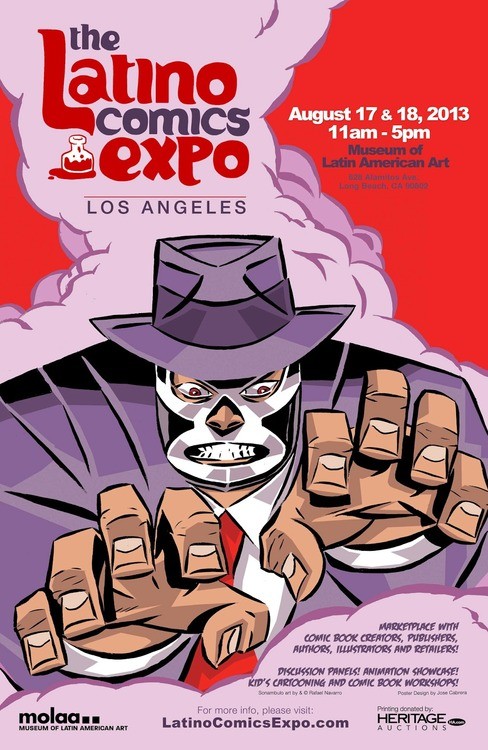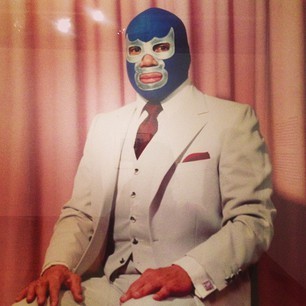
For two days at the Museum of Latin American Art in Long Beach, over fifty Latino artists and comic writers convened under one roof to bring forth their work to the public and network with fellow artists and fans. Some real legends were here: Rafael Navarro, Lalo Alcaraz, Mario Hernandez– and even a masked luchador named Lestat.
Besides the tabling artists, visitors were able to check out kiddie workshops and panel discussions that touched on topics such as DIY publishing, sixty years of luchadores in comics, and Latinas in comics.
]
The first Latino Comics Expo took place in 2011 in San Francisco's Cartoon Art Museum. The mission of the expo, founded by artists Javier Hernandez and Ricardo Padilla, was to bring more exposure to talented Latino/a artists who made huge contributions to the comic industry, but would not have been given much notice at other conventions such as your annual Comic Con.
“It was always heartbreaking to see one Latino artist in the corner, one Latina way over there amongst all the Twilight, Star Wars, and I'd just be like 'Wow look at all that creativity,' but nobody's focusing on him,” Hernandez said. “So it was just a desire to get the spotlight and attention on all this amazing talent in one place where you didn't have to share the focus with all the commercial, corporate stuff going on.”
Earlier in 2013, the Museum of Latin American Art asked Padilla and Hernandez to bring the expo to Long Beach. This time around, the expo was the biggest it had ever been; while the first LCE featured about eleven or twelve artists, last weekend featured over fifty. Padilla said that this year, over 25% of the artists were Latinas, pushing for more inclusiveness among the sexes.
All around, the range of artists was diverse; from big time comic artists to independent zinesters to theater troupes, some exhibitors displayed innovative, unconventional storytelling formats beyond pages in a book.

One lingering presence at the expo was the masked luchador. Just down the hall from the expo hung gigantic images and archives of luchadores from the golden age of Mexican wrestling for MOLAA's Katharsis show, featuring El Santo, Blue Demon and Mil Mascaras.
The panel discussion “60 Years of Mexican Masked Wrestlers in Comics” delved into an enviable archive of some of the coolest classic comics featuring El Santo and Blue Demon. The audience “ooh-ed” and “ahh-ed” at the page scans that displayed the fine art methods used to create each mini-narrative: artists then used photo collage, painting and illustration to churn out three new issues a week, selling billions of copies at the height of their popularity in the late 1960s.
“It wasn't like an artists' space where they sat in offices drawing on art boards to create these, it was a factory where guys used Exacto knives to cut out El Santo from a photograph and stick him on a painting with a monster, they worked under three art directors. They were overworked.” said panel host Keith Rainville. Production would cease around the 1980s, when editor Jose G. Cruz left the company abruptly and moved to the states.
[
Today, as they were back then, luchadores are superhero figures in comics, and continue to appear in contemporary comics such as Rafael Navarro's Sonambulo and Jason Gonzalez's La Mano Del Destino. But instead of fighting monsters and ghouls, Sonambulo is a crime fighting hero, while La Mano Del Destino lives in an alternate post-WWII Mexico whose economy prospered. “It's like Mad Men, but with Mexican wrestlers,” said Gonzalez.
Previous depictions of Latin American superheroes portrayed less than favorable images of Latinos. Professor Frederick Aldama discussed in his lecture “Spandexed Superheroes” the awful beginnings of Latino inclusiveness in the DC and Marvel world. For instance the 1984 DC character Vibe was both poorly created and received, making Latino superheroes seem like a gimmick. But as Aldama described, time would heal the wounds of colorful superheroes as more Latinos entered the comics industry and began to shape fuller, more complex narratives for Latino superheroes- from original, new superheroes (Sonambulo!) to Latino interpretations of the classics, like Araña (Latina Spiderman!).
The future of the expo seems up in the air, but Padilla noted that its popularity this weekend showed the interest in Latino/a comic artists, and the hunger for Latin American perspectives in comics. “We've already been invited to do the expo here again next year, San Jose has offered us a spot, people in the East Coast are starting to say 'we need this in the East Coast.' The demographics are there, that would be our dream to expose all this talent to our people and our generation.”
The growth in the expo is a good thing, but Padilla stated it could be a case of “too much of a good thing,” Padilla and his co-founder Hernandez had to turn away tons of artists to fit in forty tables. Finding sponsors is another issue. “We're a couple of good sponsors away from taking it to the next level, but we want to keep it classy, we don't want too much corporate takeover. We're also trying to keep this event in museums, because the focus is to get more young kids to more museums., and to make comics as a bridge to literacy.”
Email: am******@oc******.com Follow OC Weekly on Twitter @ocweekly or on Facebook!
Aimee Murillo is calendar editor and frequently covers film and previously contributed to the OCW’s long-running fashion column, Trendzilla. Don’t ask her what her favorite movie is unless you want to hear her lengthy defense of Showgirls.

